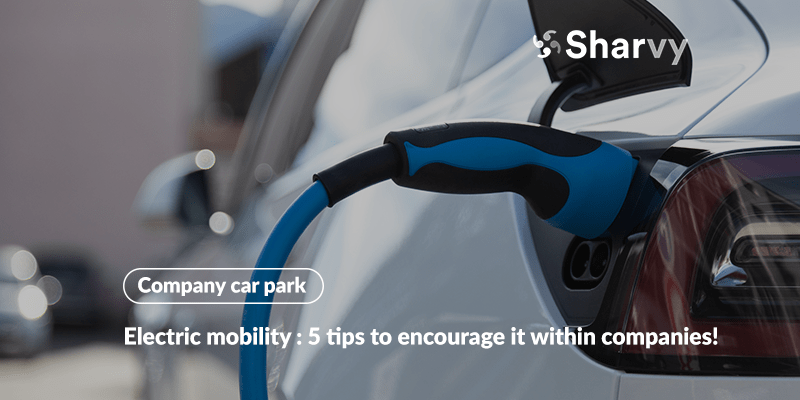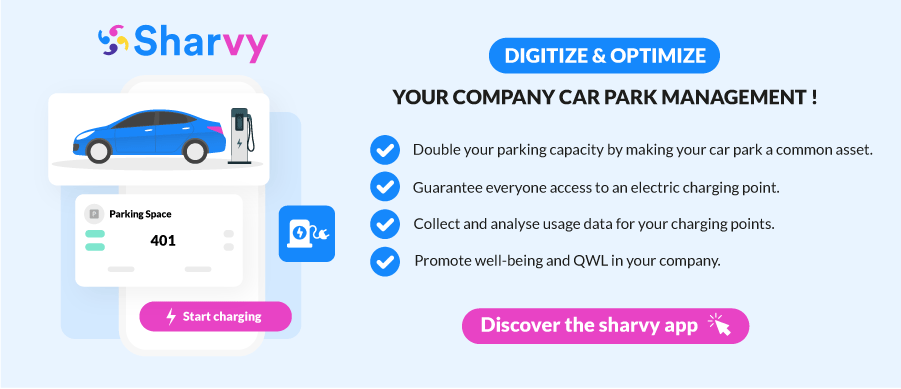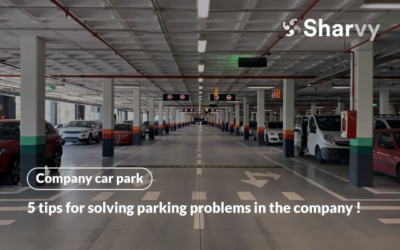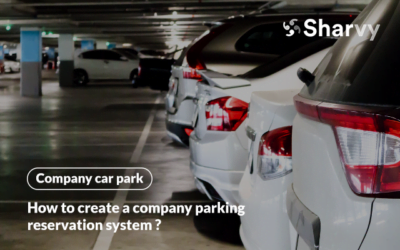In a world where environmental concerns increasingly shape our individual and collective choices, the imperative to rethink our modes of transportation becomes an undeniable necessity. At the heart of this revolution emerges electric mobility, an innovative alternative that promises to combine operational efficiency and environmental commitment. On this point, companies play a pivotal role in adopting sustainable solutions, both to meet regulatory requirements and to align with the growing expectations of employees and stakeholders.
However, integrating electric mobility within companies still raises a series of questions and obstacles, ranging from charging infrastructure to cost management, and including the necessary organizational changes.
So, how should we proceed? What solutions are conceivable? And most importantly, how can we promote and ensure the long-term adoption of electric mobility among employees? All the answers in this article.
Electric Mobility within companies in the United Kingdom.
Undoubtedly, the current context in the United Kingdom demonstrates a strong commitment to promoting electric mobility within companies.
For example, a key measure was implemented as part of UK regulations. Since 1 June 2022, all new non-residential buildings with more than ten parking spaces must install at least one charging station for every five available spaces (equivalent to 20% of the spaces). This requirement also applies to non-residential buildings undergoing significant renovations.
This policy is part of a broader effort to achieve carbon neutrality goals. The ambition is to end the sale of new combustion engine vehicles by 2030. The British government hopes this initiative will create 145,000 new charging stations each year.
To financially support companies in this transition, the “Workplace Charging Scheme” has been introduced. This scheme offers a subsidy covering up to 75% of the costs for purchasing and installing charging stations, including VAT. This is capped at 350 pounds sterling per socket and up to 40 sockets per applicant.
Finally, beyond these regulatory obligations, the government also provides incentives to encourage businesses to electrify their vehicle fleets. These measures aim to make electric mobility more accessible while reducing greenhouse gas emissions.
The challenge in the United Kingdom remains to convince stakeholders, especially employees, of the importance and benefits of transitioning to cleaner and more sustainable vehicles.
But unfortunately, several challenges persist.
Charging infrastructure remains a major obstacle. There is a need for further development and densification to meet the growing demands of employees. Moreover, the initial costs of electric vehicles can also discourage adoption. While although financial incentives and long-term savings on operating costs may offset this initial investment.
Beyond that, many drivers are still concerned about the possibility of not being able to travel long distances without recharging. Moreover, the relatively long charging times compared to traditional fuel refilling can discourage many.
As a result, employees are still hesitant to switch to electric. Increased awareness efforts and financial participation may prove necessary.
Why accelerate and encourage the development of electric mobility within your company?
As a company, you’re at a crossroads where adopting and promoting electric mobility is no longer just regulatory requirement but also essential pillar for meeting the evolving expectations of your employees.
Beyond the legal constraints, electric mobility has become a service expected by many employees. It reflects their growing sensitivity to environmental issues & sustainable mobility. By offering electric transportation solutions, such as electric recharging infrastructure directly on company parking lots, you reinforce your image. You show yourself as a responsible employer & attentive to your employees’ concerns.
In parallel, promoting electric mobility constitutes a major competitive advantage in the talent war. In an competitive job market, you stand to benefit from proposing innovative & sustainable solutions to attract and retain the best profiles. Many candidates, are aware of how their professional choices on the environment. They pay particular attention to the corporate social responsibility policies of companies. Implementating electric mobility solutions can play a decisive role in their decision.
If the development of electric mobility attracts diverse talent, it also helps retain your human capital. You provide working conditions that align with your employees’ values and aspirations.
Therefore, by adopting a forward-looking approach, you inject new dynamics into your organization. You reconcile economic performance, social responsibility, and environmental respect.
How can you promote electric mobility within your company ?
1. Install shared charging stations in your company parking lot.
There’s no doubt about it: today, one of the barriers to purchasing an electric or plug-in hybrid vehicle is the charging infrastructure, which is not yet comprehensive enough in France.
Freeway service areas are equipped with charging stations. However, this only accounts for 10% of charging. In contrast, 90% of charging is carried out at home & in the workplace. As a result, it’s easy to see that businesses have a key role to play in encouraging the transition to electric mobility.
Moreover, the workplace is an ideal location for charging. Parking spacesare already available, and vehicles typically remain stationary for a period of at least eight hours.
Therefore, by offering shared, accessible, and convenient charging stations in your company’s parking lot, you greatly facilitate the adoption of electric vehicles by your employees. This easy access to charging addresses one of their main concerns, namely the range and availability of charging points. This helps overcome a significant barrier to adopting this alternative.
Finally, the presence of electric charging stations in your company’s parking lot can create a “positive ripple effect” among your employees. In other words, seeing their peers adopting electric vehicles and using the charging stations, other employees may be encouraged to follow suit. This strengthens the social norm in favor of electric mobility within the organization.
To facilitate the management of your shared charging stations, use the Sharvy application. You’ll be able to provide your employees with a real reservation interface, so that everyone has access to a charging station for electric and plug-in hybrid vehicles. Promote low-carbon mobility and significantly improve your CSR policy.
2. Offer your employees attractive financial incentives.
Clearly, financial incentives can also play a crucial role in encouraging the adoption of electric mobility among your employees.
For instance, you can initially choose to lighten the financial burden associated with using electric vehicles by reducing, or even eliminating, the charging fees at your workplace. By offering free (or low-cost) access to charging stations, you remove a major financial barrier to using electric vehicles, making this option much more attractive to your employees.
Moreover, by covering these costs, you send a clear message about your support for the transition to more environmentally friendly mobility practices. You also enhance your brand image as a responsible employer who is concerned about environmental issues.
Furthermore, your company can also offer tax benefits and discounts on insurance premiums for employees who drive electric vehicles. These additional benefits are valuable and reward those who choose to engage in electric mobility.
These incentives help to reduce financial barriers to entry, but they also strengthen your company’s commitment to sustainability.
3. Offer home recharging solutions for your employees.
In addition to the charging stations installed at your company’s parking lot, you can also equip your employees with home charging stations. This is a way to help them transition from conventional to electric vehicles!
In this way, you offer an additional convenience that can greatly facilitate the adoption of electric vehicles. Your employees can perform their charging directly at home, without having to change their lifestyle habits or worry about the availability of charging stations.
Moreover, you significantly improve their well-being and comfort. With this benefit, they no longer have to plan their day around charging constraints. They also don’t have to worry about potential queues at public charging stations, which saves them time and energy. Consequently, you reduce a potential source of stress related to these commutes.
However, if installing a private charging point still concerns only a defined group of employees (notably those with a company vehicle), managing these remote stations can be daunting for some companies.
But do not panic! In addition to optimizing the management of charging stations in your company’s parking lot, the Sharvy solution also facilitates the management of home stations.
Your fleet manager can monitor, via the app, the consumption related to battery charging (calculated independently) from household consumption. This way, you can easily reimburse the equivalent kWh to your employees. They no longer need to submit a consumption report to the employer, a cumbersome and error-prone process.
Result: it’s more comfort for your employees who return home to charge their vehicle to 80% (or 100%) overnight and on weekends, for example, and it’s a time saver for your fleet manager.
4. Create partnerships with dealerships to offer attractive rates to your employees.
If you want to commit (even) more resources, you could potentially create partnerships with dealerships to offer attractive rates to your employees. Undoubtedly, this constitutes a wise strategy to encourage the shift towards electric mobility within your company.
By partnering with dealerships specializing in electric vehicles, you can offer your employees preferential rates that reduce the initial cost of purchasing or leasing an electric vehicle. Clearly, this already makes the transition more accessible and appealing to your employees.
Moreover, these partnerships often include special offers, such as maintenance services and extended warranties, enhancing the appeal of this solution. Not to forget that these can (sometimes) offer companies access to a diverse range of vehicles, giving employees a broader choice of models depending on their needs and preferences.
Finally, by creating strong ties with dealerships, you can benefit from additional services such as flexible leasing offers and advantageous financing options, making the purchase and leasing of electric vehicles even more attractive!
Ultimately, these partnerships provide a comprehensive & personalized approach to encourage the shift to electric mobility, while reinforcing your company’s commitment to sustainability and the well-being of your employees.
5. Encourage managers & senior executives of your company to adopt electric vehicles and share their experiences with colleagues.
Undoubtedly, managers and senior executives embody the values of your company. They are often influential figures and can (easily) stimulate motivation and engagement among your employees.
That’s why, if they adopt electric vehicles and share their experiences, they can help demystify this solution and dispel any potential reluctance your employees might have about making the change. In doing so, they create an environment conducive to learning and awareness.
Moreover, when managers take the initiative to switch to electric vehicles, it sends a powerful message about the importance of transitioning to more environmentally friendly mobility solutions, thereby inspiring confidence.
In conclusion
By investing in electric mobility, you are taking a bold step towards the future, and you are offering your employees the opportunity to redefine the way they commute from home to work.
Moreover, you position yourself as a forward-thinking company, inspiring others to follow your example and contribute to accelerating the transition to a more responsible future.
Imagine the positive outcomes: your employees proud to be part of a visionary company, reduced operational costs thanks to more efficient vehicle fleets, and a significant contribution to the fight against climate change. So, do not underestimate the power of your company to drive change. Take the wheel now and make electric mobility a reality within your organization.
Have a question? Check out the FAQ!
To lead your electric mobility project, which internal stakeholders should be involved in the discussions?
Undoubtedly, integrating electric mobility into a company can be a complex process that must involve stakeholders both internal and external to the company.
For example, among the internal stakeholders, you might choose to consult your fleet manager (responsible for managing your company’s parking). You could also include the Human Resources (in charge of managing rebilling & benefits in kind). Obviously, your Facility Manager (in charge of general services & standards related to your site) also has a place in these discussions. Similarly, General Management and the CSR Department are also key players, whether to communicate internally on your company’s electric mobility policy, or to define & coordinate actions to comply with sustainable development standards.
Parallelly, on the side of external stakeholders, you can engage several service providers who possess varied skills. Notably, an independent electrical installer who will carry out the installation and commissioning of charging stations, for example. Also, technology partners, like the Sharvy solution, which manages access to charging stations, billing for recharges by providing the badge and/or application for recharging whether at a station on your company’s parking lot, or roaming at your employees’ homes.
Why use an application like Sharvy to manage your charging stations?
As legal requirements for company fleets evolve, with the obligation for companies to renew part of their fleet with electric vehicles and to establish charging infrastructures, effective management of these stations becomes crucial. The increase in the number of these stations in company car parks, will inevitably complicate their management. This is where Sharvy comes in.
By anticipating the conversion of the car fleet from internal combustion to electric, Sharvy allows fleet managers to efficiently plan the transition stages, ensuring optimal distribution of electric charging stations on the company site. Moreover, by facilitating and optimizing the operation and maintenance of charging stations, Sharvy provides a comprehensive solution for companies to meet the growing needs for electric mobility.
Therefore, by centralizing all information & operations related to charging stations within a single intuitive platform, Sharvy simplifies the daily management of charging infrastructure for your fleet managers, while ensuring optimal use of resources and a smooth user experience. In short, using an application like Sharvy is a wise investment for companies wishing to adapt effectively to new regulatory requirements & take full advantage of the benefits of electric mobility.
Want to learn more? Check out our latest articles to stay up to date!
Company carsharing : how to organize and promote it?
In this article, we focus on 5 simple & effective actions to take to organize & promote company carsharing!
5 tips for solving parking problems in the company
Is your company car park experiencing parking problems? Discover our 5 tips for a simple solution.
How to create a company parking reservation system?
Company car park can cause frustration among employees. How do you create a parking reservation system that satisfies everyone?
Subscribe to our newsletter!
Resources
Contact us






